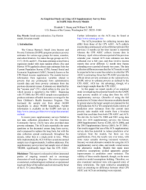An Empirical Study on Using ACS Supplementary Survey Data in SAIPE State Poverty Models
An Empirical Study on Using ACS Supplementary Survey Data in SAIPE State Poverty Models
Introduction
The Census Bureau’s Small Area Income and Poverty Estimates (SAIPE) program produces poverty estimates for various age groups for states, counties, and school districts. For states the age groups are 0-4, 5-17, 18-64, and 65+. The state estimates come from a regression model with state random effects (Fay and Herriot 1979) applied to direct state estimates from the Current Population Survey (CPS) Annual Social and Economic Supplement (ASEC, formerly known as the CPS March income supplement). The models borrow information from regression variables related to poverty that are constructed from administrative records data and from poverty estimates from the previous decennial census. Estimates are identified by the “income year” (IY), which refers to the year for which income is reported in the ASEC. Beginning with IY 2000, the CPS ASEC sample was expanded to produce estimates of health insurance coverage for the State Children’s Health Insurance Program. This increased the sample size from about 60,000 households to about 98,000 households.




